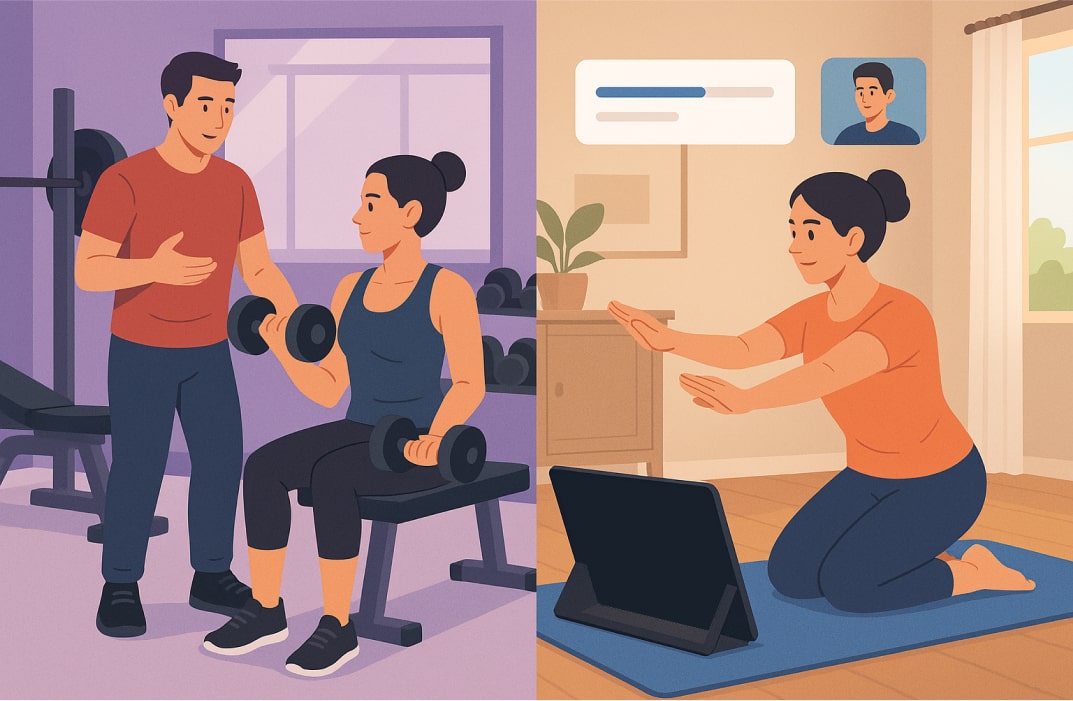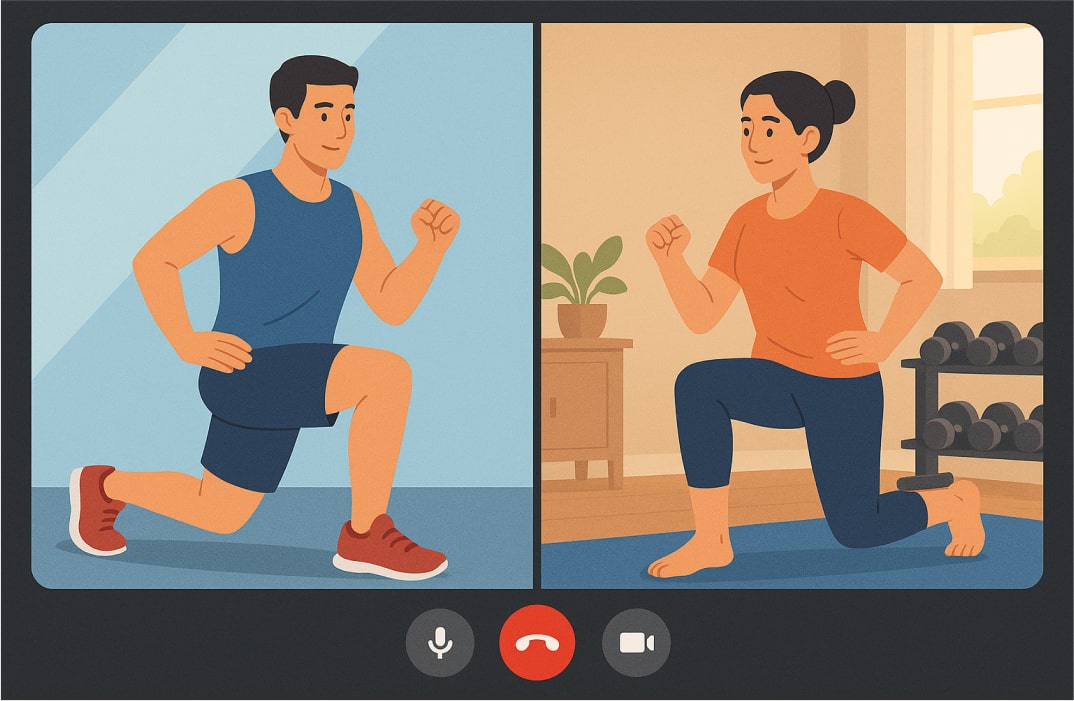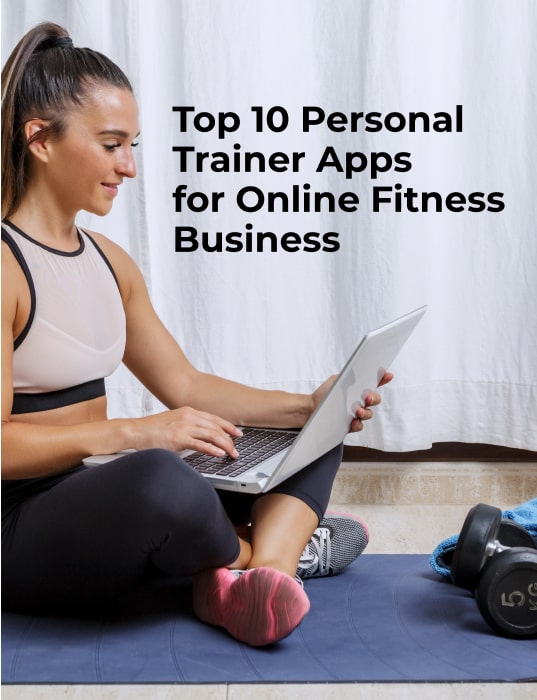Are You Earning Up to Your Potential?
Most personal trainers are undervaluing their time and skills. Our Personal trainer Revenue Calculator helps you find out what you should be making, and how to get there.
No guesswork. Just real numbers.
.jpg)
In the ever-evolving world of fitness, one trend has risen above the rest: online personal training. What was once a niche option for those with busy schedules has become a cornerstone of the fitness industry. In 2025, online personal trainers are revolutionizing how people achieve their fitness goals, offering convenience, flexibility, and expert support all from the comfort of their own homes.
Whether you're a personal fitness coach online, an aspiring online fitness coach, or someone exploring new ways to train, this guide to online personal training in 2025 will show you how to make the most of the virtual fitness revolution.
What Is Online Personal Training?

Online personal training is a virtual method of delivering fitness coaching through digital platforms, including mobile apps, video calls, and online programs. Unlike traditional in-person training, it allows clients and trainers to connect from anywhere in the world.
Instead of meeting your trainer at a gym, you receive a personalized training plan, nutrition guidance, and regular support via your phone, laptop, or tablet. This digital shift has made personal training online more accessible, particularly for those who juggle tight schedules or work out at home.
Why Online Personal Training is Booming in 2025
Several factors contribute to the rapid rise of online personal fitness training:
1. Flexibility and Convenience
Training on your own time is one of the biggest perks. Whether you're squeezing in a quick cardio session before work or doing strength training at midnight, online training adapts to your life, not the other way around. This flexibility is especially beneficial for busy professionals, parents, or travelers who can't commit to rigid gym hours. With the option to schedule sessions around your lifestyle, maintaining a consistent fitness routine becomes more realistic than ever.
2. Access to the Best Trainers Worldwide
No longer limited to local options, clients can now work with expert training professionals from anywhere—celebrity coaches, niche fitness professionals, and specialists in sports medicine are just a few clicks away. This global access allows individuals to find online personal trainers who truly align with their goals, personality, and preferred coaching style. Whether you're seeking a yoga expert in India or a strength coach in New York, the possibilities are limitless.
3. Affordability
Without overhead costs such as gym space, equipment maintenance, or front desk staff, online personal fitness trainer services often come at a lower price than traditional in-person trainer rates, making them more budget-friendly. Many online fitness coaches offer tiered pricing options, ranging from fully customized coaching to more general group programs, making high-quality coaching accessible to people with varying budgets.
4. Personalization at Scale
Thanks to advanced online personal training software and fitness apps, personalized workouts, meal plans, and even immediate feedback can be delivered at scale—something unimaginable just a decade ago. AI-driven systems and smart tracking enable online personal trainers to adjust programs in real-time based on client feedback, biometric data, and progress. This means you're always following a plan tailored to your unique needs, regardless of the number of clients a coach is handling online.
5. Increased Accountability and Motivation
Features like progress tracking, habit logs, and real-time messaging help clients stay accountable to their fitness journey and maintain long-term consistency. Some platforms also include weekly check-ins, video form reviews, and gamified milestones to keep users engaged. By integrating mental health and lifestyle coaching into their offerings, many virtual personal trainers are helping people stay not only physically active but also emotionally and mentally committed.
Online vs. In-Person Training: What's the Difference?
Let's compare:

The choice between a virtual personal trainer and an in-person trainer ultimately depends on your goals, motivation style, and environment.
💪 Got an idea for a brand? Let's bring it to life.
Launch your own fitness app with FitBudd in minutes!

💪 Got your brand name? Let’s bring it to life.
Launch your own fitness app with FitBudd in minutes!


88% trainers worldwide gave us 5 stars
Transform your fitness business with the power of your branded app on iOS and Android.
Try for FREETypes of Online Personal Training Models
In 2025, online personal trainers use several delivery models supported by virtual personal trainer apps and gym CRM software to fit different goals, preferences, and lifestyles:
1. One-on-One Virtual Training

This model mirrors traditional personal training, delivered via video calls. Sessions may include real-time correction, encouragement, and adaptation. It enables personalized training plans, close monitoring of form, and direct interaction with the trainer, fostering a strong coach-client relationship. Ideal for those who thrive on immediate feedback and expert guidance, it brings a personal touch to the virtual fitness space.
2. Hybrid Training
Clients meet their trainer in person once a week but follow a digital plan the rest of the time. It offers the best of both worlds: face-to-face connection for form checks and motivation, and the freedom to train on your own time during the week. This model is especially popular with clients transitioning from in-person training to online personal fitness training or those who need occasional hands-on support.
3. Group Virtual Training

Using platforms like Zoom or Google Meet, online trainers run live sessions with multiple participants. It's cost-effective, community-driven, and energizing—ideal for those who enjoy training with others and drawing motivation from the group. These sessions often include cardio, yoga, or HIIT classes and may incorporate progressive overload principles while promoting accountability through group dynamics.
4. Self-Guided App-Based Training
Pre-recorded workout programs, featuring detailed instructions, demo videos, and progressive challenges, form the core of this model. Many platforms also include features for nutrition tracking, mental health journaling, and personalized habit-building tools. It's ideal for independent learners who want the structure of a fitness program without scheduled sessions, allowing them to train at their own pace in the comfort of their own home or gym.
Benefits of Online Personal Training for Clients
Whether you’re new to fitness or chasing advanced goals, online coaching can be a game-changer. With greater accessibility and customization—and the accountability that fitness trainer software provides online personal training in 2025 fits a wide range of clients.
Personalized Plans
Every person is unique, and a good online personal trainer creates a customized training plan tailored to your fitness level, goals, and lifestyle. From specific weight loss targets to building core strength or training for a race, your plan is aligned with your capabilities and preferences. The best part? It evolves as you do—incorporating progressive overload, adapting to injuries, and adjusting based on your feedback and schedule.
Workout from Anywhere
Whether you're at home, on vacation, or at a local gym, your training travels with you. No need to cancel sessions or skip workouts when life gets busy—your plan and online coach are just a few taps away. This level of flexibility ensures that your fitness journey continues uninterrupted, even across time zones or during unexpected schedule changes.
Cost-Effective
You can often get complete support—including nutrition guidance, video feedback, and regular check-ins—for a fraction of what you'd pay for weekly in-person sessions. Many platforms offer monthly subscriptions or tiered packages, making online personal fitness training more accessible to a broader audience. Whether you want high-touch, one-on-one coaching or a more budget-friendly group or app-based program, there's an option to fit your wallet.
Focus on Progress
Most online personal training platforms include robust progress tracking tools, enabling you to measure key metrics such as core strength, body weight, reps, and even energy or mood over time. Some platforms integrate with fitness apps or smart wearables to give your trainer deeper insights into your habits and results. This data-driven approach helps you stay focused, identify patterns, and celebrate both big and small wins.
Whole-Person Wellness
A great online coach doesn't just focus on workouts, but on your overall health. That includes daily habits, sleep quality, stress management, and mental health. Many coaches now offer integrated wellness features, including habit tracking, journaling prompts, and mindfulness practices. The goal isn't just to help you get fit, but to support a more balanced and resilient version of you.
How Trainers Can Succeed in the Virtual World
Are you a fitness professional looking to transition to a virtual setting? With the growth of online personal fitness training, 2025 presents the perfect opportunity to scale your business, reach new clients, and make a bigger impact. Here's how to set yourself up for success in the world of online personal training:
1. Choose the Right Platform
Select a reputable online personal training software that provides the necessary tools to run your business efficiently. The right platform should allow you to:
- Create and schedule workouts with video demos and customizable templates
- Host video calls for real-time coaching, form corrections, and consultations
- Share files and meal plans to support your client's complete fitness journey
- Track client progress through integrated dashboards and visual reports
- Manage payments and bookings with automated reminders and secure processing
Choosing the right tech stack can make all the difference in how efficient and professional your services feel. Popular platforms in 2025 include Trainerize, TrueCoach, and FitBudd—each offering tailored features for virtual personal trainers and scalable program delivery.
2. Nail Your Niche
Whether it's weight loss, yoga, strength training, or sports performance, clearly define who you serve and how you help them. Instead of trying to appeal to everyone, focus on a niche where your passion and expertise meet a specific demand. Position yourself as the go-to online coach for that audience.
For example:
- "Online Personal Trainer for New Moms"
- "Virtual Strength Coach for Runners"
- "Online Fitness Coach Specializing in Desk Workers"
This kind of niche clarity not only attracts your ideal clients but also helps your messaging, branding, and content resonate in a crowded market filled with several trainers.
3. Develop Signature Programs
Instead of offering generic services, build goal-driven, branded fitness programs that deliver a specific outcome. These can be sold as one-time purchases, part of a coaching package, or even automated into a self-guided experience.
Sample ideas:
- "8-Week Home Workout Challenge" – Minimal equipment, maximum results
- "Beginner's Guide to Building Strength" – Focused on form, technique, and progressive overload
- "Busy Moms Weight Loss Journey Bootcamp" – Includes meal plans, time-saving workouts, and mindset coaching
Signature programs add professionalism and scalability to your online personal training business, providing clients with a clear roadmap to follow.
4. Offer a Trial Session
A free or low-cost trial session can help hesitant prospects experience your coaching style firsthand. Use this session to assess their fitness level, discuss goals, and showcase how your personalized training plan can help them. It's also a great way to build rapport, answer questions, and eliminate objections before asking them to commit.
Trial sessions can be:
- A 30-minute video consult
- A sample week of training in your app
- A free virtual training class or workshop
This strategy builds trust and gives potential clients online a taste of the value you bring.
5. Stay Connected
Success in online training hinges on maintaining consistent communication and fostering strong relationships. Unlike in-person training, where motivation and accountability are often delivered in real time, virtual trainers need to be proactive.
Use tools such as:
- In-app messaging to check in and celebrate wins
- Video check-ins for coaching reviews and progress updates
- Progress reports to highlight improvements and areas for growth
Adding layers of accountability—even digitally—helps clients stay engaged and committed to their goals. When clients feel seen, supported, and guided, they're more likely to stick with your program and refer others.
Features Clients Should Look for in an Online Personal Trainer
If you're seeking a personal trainer online, don't just choose the cheapest option or the first profile you see on social media. In 2025, the market is saturated with online trainers, so it's essential to find someone who offers real value, professionalism, and long-term support for your fitness journey. Here's what to look for:
Credentials from Recognized Organizations
Make sure your trainer holds certifications from reputable bodies such as the American Council on Exercise (ACE), NASM, or NSCA. These credentials indicate they've been trained in proper programming, safety, anatomy, and behavior change—essential skills for providing expert training. Bonus points if they have continuing education in sports medicine, nutrition, or specialized populations (such as older adults or postpartum clients).
Experience with Your Fitness Level and Goals
Your online personal fitness trainer should have hands-on experience working with clients at your fitness level—whether you're a beginner starting from scratch or an athlete aiming to optimize performance. Ask about their background working with clients who have similar goals, such as weight loss, core strength, muscle gain, or recovery from injury.
Proven Results and Testimonials
Look for social proof, such as testimonials, transformation stories, or before-and-after progress photos. A great online coach will have a track record of helping clients achieve measurable progress through realistic and sustainable programs. Even better, they will have reviews on third-party platforms or their training app profile.
Relevant Specializations
Not all trainers are the same. Some specialize in yoga, while others focus on strength training, rehabilitation, integrating, or mental health. Choose a coach whose background aligns with your specific needs. If you're recovering from an injury, for instance, a trainer with a sports medicine background will serve you better than a generalist.
Truly Personalized Training Plans
Avoid trainers who send the same generic PDF to every client. Your personalized training plan should reflect your specific fitness goals, access to equipment, schedule, and any limitations you may have. A quality online personal trainer will assess your needs and create a tailored plan that incorporates progressive overload, deload phases, and rest days tailored to your lifestyle and ability.
Easy-to-Use Online Tools or App
Since everything is digital, ensure the coach utilizes intuitive and professional online training software. Having a custom-branded app from a trusted platform like FitBudd can assist you to:
- Access your workouts easily
- Watch demo videos
- Message your trainer
- Track progress and metrics
- View meal plans or recovery tips
User experience matters—if it's too confusing, you're less likely to stay consistent.
Essential Tools for Online Personal Training in 2025
To thrive in the online personal training world, both virtual personal trainers and clients require access to the right tools. In 2025, technology will play a central role in delivering results, tracking progress, and ensuring smooth communication. Here are the essential tools to build a practical and engaging virtual fitness experience:
Fitness Apps
These are the backbone of online training, helping trainers deliver structured workouts, track activity, and provide guidance on nutrition and diet. Clients use these apps to log exercises, track calorie intake, view video demonstrations, and receive real-time updates. Leading apps often come with habit tracking, daily reminders, and progress dashboards to help clients stay accountable on their fitness journey.
Video Conferencing Tools
Whether for live coaching, form checks, or initial consultations, platforms like Zoom, Google Meet, or built-in features in online personal training software enable real-time interaction. This brings a human connection to virtual personal training, allowing immediate feedback, motivation, and encouragement, just like in a physical gym session.
Wearables
Smartwatches and fitness trackers (like Apple Watch, Fitbit, or Garmin) have become essential for online personal fitness training. These devices monitor steps, heart rate, calories burned, sleep quality, and more, providing both trainers and clients with valuable data to personalize programs and enhance outcomes. Many devices also sync with fitness apps for seamless integration.
Online Personal Training Software
This is where the magic happens for fitness professionals. Platforms like FitBudd, Trainerize, or My PT Hub allow trainers to manage every aspect of their business—from scheduling and payments to program delivery and progress tracking. These tools also help build branded experiences, house educational content, and offer messaging features for ongoing support.
Progress Tracking Tools
Seeing tangible results is crucial for motivation. Whether it's visual progress photos, strength benchmarks, weight trends, or completed habits, progress tracking tools let clients and trainers monitor change over time. These insights help optimize future workouts, celebrate milestones, and ensure the client is always moving forward on their fitness journey.
Nutrition Tools
Meal planning and dietary tracking are essential for achieving goals such as weight loss, muscle gain, or enhanced energy levels. Apps like MyFitnessPal, Cronometer, or trainer-provided meal plans allow clients to log food, calculate macros, and stay aligned with their nutrition goals. Some advanced coaching platforms even enable trainers to deliver and update personalized meal plans within the app itself.
Overcoming Challenges in Online Fitness Coaching
While online personal training offers immense flexibility and reach, it also comes with its own unique set of challenges. For virtual personal trainers to be truly effective, they must anticipate and address these obstacles with innovative strategies and client-centered solutions.
No Physical Touch
In in-person training, physical adjustments help correct posture and technique. In the virtual training world, that tactile feedback is missing.
Solution:
Utilize high-quality video calls to demonstrate movements from multiple angles visually. Combine that with clear verbal cues, slow-motion breakdowns, and analogies to help clients understand what proper form looks and feels like. Encouraging clients to film their exercises for form reviews between sessions also adds value and improves safety.
Client Motivation Drops
Staying consistent without the physical presence of a coach can lead to dips in motivation, especially for those new to working out or pursuing long-term fitness goals, such as weight loss or strength development.
Solution:
Combat this with regular check-ins, motivational messages, and milestone celebrations. Incorporate gamification elements, such as progress badges, streaks, and challenges, to enhance the experience's engagement. Keeping clients emotionally connected to their fitness journey builds long-term adherence.
Equipment Limitations
Not every client has access to a gym or a complete set of weights, especially when training from a home gym or while traveling.
Solution:
Design personalized workouts that utilize bodyweight exercises, resistance bands, dumbbells, or even everyday items like backpacks, towels, or water bottles. Offering multiple equipment options for each workout ensures inclusivity and allows clients to continue progressing, regardless of what equipment is available.
Tech Troubles
Not all clients are tech-savvy, and a clunky app or confusing interface can discourage them from sticking with their program.
Solution:
Select user-friendly fitness apps and online personal training software like FitBudd, which offers a clean interface, intuitive navigation, and a seamless client experience. FitBudd also allows trainers to customize branding and deliver everything—workouts, meal plans, progress tracking, and communication—in one place. Provide onboarding videos, how-to guides, or even a short welcome call to walk clients through the platform. The smoother the digital experience, the more confident and consistent your client will be.
Sample Weekly Online Training Plan
Here's what a week of online personal training might look like:
The Business of Online Training
In 2025, online personal training isn't just about fitness—it's a thriving business opportunity.
- Many fitness professionals now generate between $5,000 and $6,000 per month.
- Online trainers can serve 10x more clients than in-person trainers.
- Digital products (like PDF guides and training templates) create passive income.
To scale your online personal fitness trainer business, focus on:
- Automating onboarding
- Creating content (blogs, social media, YouTube)
- Collaborating with other fitness or health brands
- Using testimonials to build trust
The Bottom Line
Online personal training in 2025 is more than just a trend—it's a more innovative and flexible way to achieve results. Whether you're looking to improve your health, lose weight, or gain strength, the support of a skilled online personal trainer can make all the difference.
No matter your fitness levels, schedule, or location, you now have access to expert guidance, accountability, and proven methods that empower you to succeed in your fitness journey—on your terms.
Frequently Asked Questions
In 2025, the cost of an online personal trainer can range from $50 to over $300 per month, depending on the level of support, personalization, and the trainer's experience. Self-guided programs or app-based plans: $50–$100/month Customized plans with check-ins: $100–$200/month Premium one-on-one coaching with video calls: $200–$300+/month Some coaches also offer pay-per-session rates, bundled packages, or group programs at lower prices. The key is to find a plan that fits your goals, schedule, and budget.
Yes, an online personal trainer is worth it—if you value flexibility, affordability, and expert support. With access to personalized training plans, nutrition guidance, and progress tracking, many clients achieve results that rival or even surpass those of traditional in-person training. It's especially effective for people who need convenience, accountability, or guidance while training at home or on a busy schedule.
Yes, personal training can be done online through video calls, fitness apps, and virtual platforms. Trainers create custom workout programs, demonstrate exercises, monitor progress, and provide support—all remotely. Thanks to modern online personal training software, clients can receive structured coaching, stay accountable, and get real results without ever stepping into a gym.

Creative Fitness Challenges Ebook
Discover exciting challenges to boost your workouts and keep your fitness journey thrilling.
Download Now
Templates
These functional templates have the power to make any fitness trainer's life easier.
Subscribe To
Our Blog




























